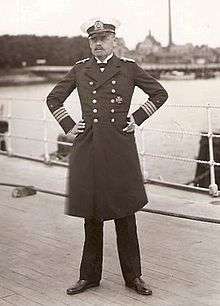Rolf Carls
| Rolf Carls | |
|---|---|
 | |
| Born |
29 May 1885 Rostock |
| Died |
24 April 1945 (aged 59) Bad Oldesloe |
| Allegiance |
|
| Service/branch |
|
| Years of service | 1903–43 |
| Rank | Generaladmiral |
| Unit |
SMS Stein SMS Mars SMS Fürst Bismarck SMS Breslau |
| Commands held |
SM U-124 SMS Hessen |
| Battles/wars |
World War II |
| Awards | Knight's Cross of the Iron Cross |
Rolf Hans Wilhelm Karl Carls (29 May 1885 – 24 April 1945) was a Generaladmiral of the Kriegsmarine during World War II and a recipient of the Knight's Cross of the Iron Cross. The Knight's Cross of the Iron Cross was awarded to recognise extreme battlefield bravery or successful military leadership and is one of the highest military leadership awards.
Career
At the start of the World War I, Carls was a member of the crew of the cruiser Breslau. He later served on the battleship König and then commanded two u-boats, first U-9 and then U-124.
After the war, Carls was made Chief of the Training Division at the Supreme Naval Command of the resurrected German navy and was then given command of the old battleship Hessen.
In 1933, Carls was made Chief of Staff of the Fleet Command, and a year later Commander-in-Chief Battleships.
Carls was Fleet Commander from 1937 to 1938 and then became Commanding Admiral for the Baltic. At the same time he held the post of Commander-in-Chief of the Naval Group Command East. Still later he became Chief of the larger Naval Group Command North.[1]
Early in 1943, Erich Raeder resigned as the commander of the Kriegsmarine after a dispute with Hitler. Raeder nominated either Carls or Karl Dönitz to succeed him, and Hitler chose Döntiz. Carls later resigned, possibly to prevent friction among the naval leadership.
Admiral Carls was killed in an air raid on Bad Oldesloe on 24 April 1945.[Notes 1] Carls together with 29 other people were killed in the cellar of the Vocational school in the Königstraße.[4]
Awards
- Iron Cross (1914)
- 2nd Class
- 1st Class (19 May 1915)[5]
- Imtiyaz Medal in Silver with Sabres (Ottoman Empire)
- Ottoman War Medal (Turkish: Harp Madalyası), better known as the "Gallipoli Star", or the "Iron Crescent" (12 August 1915)[5]
- Silesian Eagle 2nd and 1st Class (27 January 1920)[5]
- Honour Cross of the World War 1914/1918 (24 December 1934)[5]
- Spanish Cross in Gold with Swords (6 June 1939)[6]
- Clasp to the Iron Cross (1939) 2nd and 1st Class
- German Cross in Gold on 28 February 1943 as Generaladmiral in the Marinegruppenkommando Nord[7]
- Knight's Cross of the Iron Cross on 14 June 1940 as Admiral and Marinegruppenbefehlshaber Ost[8][Notes 2]
- Finnish Order of the Cross of Liberty 1st Class with Star and Swords (27 April 1942)[6]
- Grand Cross of the Order of the White Rose of Finland
- Grand Cross of the Order of the Crown of Italy
- Order of Merit of the Republic of Hungary, First Class
- Mentioned twice in the Wehrmachtbericht on 10 April 1940 and 21 October 1941
Notes
References
Citations
- ↑ http://www.feldgrau.com/kmsorg.html
- ↑ "60 Jahre nach dem Feuersturm auf Hamburg: Kreisarchiv Stormarn erhält einmaligen Fotofund". Kreis Stormarn (in German). Retrieved 14 January 2011.
- 1 2 Scherzer 2007, p. 257.
- ↑ Hitler's Navy: The Ships, Men and Organisation of the Kriegsmarine 1935 - 1945
- 1 2 3 4 Dörr 1995, p. 119.
- 1 2 Dörr 1995, p. 120.
- ↑ Patzwall & Scherzer 2001, p. 72.
- ↑ Fellgiebel 2000, p. 152.
Bibliography
- Dörr, Manfred (1995). Die Ritterkreuzträger der Überwasserstreitkräfte der Kriegsmarine—Band 1: A–K [The Knight's Cross Bearers of the Surface Forces of the Navy—Volume 1: A–K] (in German). Osnabrück, Germany: Biblio Verlag. ISBN 978-3-7648-2453-2.
- Fellgiebel, Walther-Peer (2000) [1986]. Die Träger des Ritterkreuzes des Eisernen Kreuzes 1939–1945 — Die Inhaber der höchsten Auszeichnung des Zweiten Weltkrieges aller Wehrmachtteile [The Bearers of the Knight's Cross of the Iron Cross 1939–1945 — The Owners of the Highest Award of the Second World War of all Wehrmacht Branches] (in German). Friedberg, Germany: Podzun-Pallas. ISBN 978-3-7909-0284-6.
- Patzwall, Klaus D.; Scherzer, Veit (2001). Das Deutsche Kreuz 1941 – 1945 Geschichte und Inhaber Band II [The German Cross 1941 – 1945 History and Recipients Volume 2] (in German). Norderstedt, Germany: Verlag Klaus D. Patzwall. ISBN 978-3-931533-45-8.
- Scherzer, Veit (2007). Die Ritterkreuzträger 1939–1945 Die Inhaber des Ritterkreuzes des Eisernen Kreuzes 1939 von Heer, Luftwaffe, Kriegsmarine, Waffen-SS, Volkssturm sowie mit Deutschland verbündeter Streitkräfte nach den Unterlagen des Bundesarchives [The Knight's Cross Bearers 1939–1945 The Holders of the Knight's Cross of the Iron Cross 1939 by Army, Air Force, Navy, Waffen-SS, Volkssturm and Allied Forces with Germany According to the Documents of the Federal Archives] (in German). Jena, Germany: Scherzers Militaer-Verlag. ISBN 978-3-938845-17-2.
- Die Wehrmachtberichte 1939–1945 Band 1, 1. September 1939 bis 31. Dezember 1941 [The Wehrmacht Reports 1939–1945 Volume 1, 1 September 1939 to 31 December 1941] (in German). München, Germany: Deutscher Taschenbuch Verlag GmbH & Co. KG. 1985. ISBN 978-3-423-05944-2.
External links
- Rolf Carls in the German National Library catalogue
- Helgason, Guðmundur. "WWI U-boat commanders: Rolf Carls". German and Austrian U-boats of World War I - Kaiserliche Marine - Uboat.net. Retrieved 18 August 2016.
| Military offices | ||
|---|---|---|
| Preceded by Admiral Richard Foerster |
Chief of Fleet of the Kriegsmarine 21 December 1936 – 31 October 1938 |
Succeeded by Admiral Hermann Boehm |